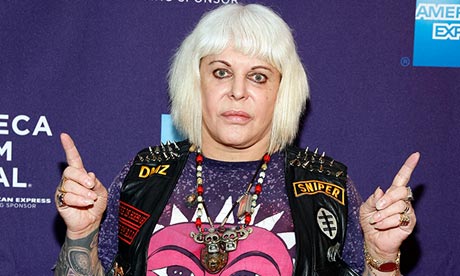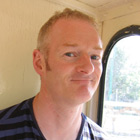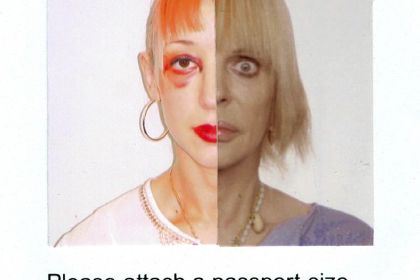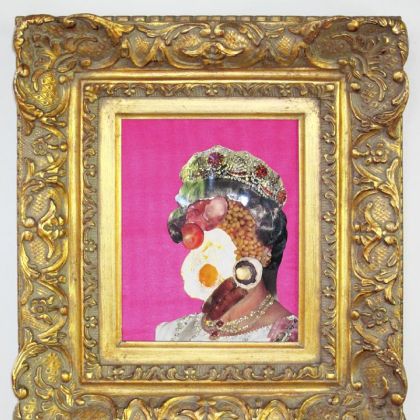
Genesis P-Orridge: 'The press portray me as outrageous, but we have a way with animals.' Photograph: Andy Kropa/Getty Images North America
Hi Genesis! Your new photographic retrospective book about your life contains images of nudity and genital mutilation. (1) Yet some fans might be more shocked by the one of you as a cute little boy clutching a rabbit.
For the first nine years of my life we (2) weren't allowed pets because of my asthma, apart from that rabbit, which lived outdoors in a hutch. But we've had dogs since 1969. The media portray me as outrageous, but we have a way with animals and can train dogs so well that they don't need leads. We once took the dog shopping, went home and two hours later thought: "Where's the fucking dog?" We ran back like a maniac and she was still there, sitting outside the butcher's.
How did cute little Neil Megson become the notorious Genesis P-Orridge?
Solihull School radicalised me in terms of who are the enemy. All the other kids were being told: "You are the future leaders of Britain. You will be MPs or military generals." Then there was me. We started an underground magazine complaining about the school rules and actually got some of them changed, like the one which insisted that boys of 6ft 4in with stubble should always wear their school cap. It was ridiculous!
Were you a bit of a handful, even then?
There's one of my old school reports in the book. The English teacher – nicknamed Bog Brush because of his moustache – put: "Neil seems to live in a completely different universe to the rest of us. Very weird but very intelligent." We'd been quoting Tibetan Buddhism in essays about Shakespeare and stuff. He did recommend Jack Kerouac's On The Road to me, though, which convinced me that people's lives should be as interesting as the art they make. A lifelong manifesto.
Were you really given a prize at Hull University by Philip Larkin?
We went there to study philosophy and economics. God knows why. Within three weeks we thought: "We can't do this." So we started writing poetry. Philip Larkin – the librarian there – gave me the prize, and not long afterwards told the Times I was the most promising young poet in Britain. Which, of course, immediately stopped me writing poetry.
Most people form bands to be famous, make money and have sex. What motivated you to form Throbbing Gristle?
Well, we were already getting plenty of sex! We'd been doing this thing called Coum Transmissions and I remember wearing gas masks outside Hull town hall and this guy in a suit rushing up asking: "Who are you people?" The British Council sent us to Milan with Gilbert and George to represent British performance art, but one day I was talking to this old man in the pub who'd been gassed in the first world war. He'd said: "I understand you're trying to wake people up. But how many people in this pub would get it? Why don't you do something accessible, like music?" So we did.
How did you invent industrial music, which became a genre that has since inspired everyone from David Bowie to Marilyn Manson to Nine Inch Nails?
It was a process of reduction. We decided we didn't want a drummer, because that would immediately anchor us in rock history. At the beginning, we hit my bass strings with a leather glove to provide a rhythm. Chris Carter started building drum machines and weird gadgets.Sleazy Christopherson experimented with tape machines and cut ups because he was into [William] Burroughs. Cosey [Fanni Tutti] wanted to play lead guitar, which at the time was unheard of for a woman. We got one from Woolworths, but she said it was too heavy. So we took an electric saw and cut off the excess wood. That's how she ended up with that style of guitar.
How did you write songs?
We jammed every weekend throughout 1975, recording everything and listening to it back so we could use the best bits. Later, we added my deadpan Lou Reed voice and the various stories. It was about taking lyrics and imagery to the logical conclusion. Nothing was too extreme. Nothing was taboo.
Your first performance – the notorious "Prostitution" show at the ICA in 1976 – catapulted you to national attention.
Yeah. We had a plastic art deco clock filled with used tampons called It's That Time of the Month. The whole country was in uproar. Now those tampons are in the Tate National Collection of Fine Art – with the Turners, the Rothkos and the Constables.'
How did it feel to be branded "wreckers of civilisation" in the House of Commons?
We were so proud. We had a flyer with that on it the very next day. The irony of it was that Sir Nicholas Fairbairn – the [Tory] MP who called us that – was involved in various sex scandals. And his mistress, a House of Commons secretary, tried to hang herself outside his office. It was classic British hypocrisy: everything we were against.
Is it true that TG's 20 Jazz Funk Greats album was returned to the shops by irate jazz funk fans compaining: "This isn't jazz funk. It's horrible noise!"?
There was a lot of dark, twisted humour in TG.
Your Twitter page says you're "STILL!" a member of TG. Does that mean the band still exists?
I never quit the band even though the others said I did. I just didn't do the last two gigs for reasons that will become clear eventually – it was the people around them on the business side. But Sleazy died not long after, so maybe it was the end of our natural life as a band.
TG and your other band Psychic TV both became international cults without entering the mainstream. Would you have liked hits?
Well Godstar (3) got to No 29. But going on Top of the Pops would have ruined everything. It would have made it much more difficult to write books, do art exhibitions and set up religions and be taken seriously. Once you have a hit, it just becomes another old song. Mick Jagger is 70 and still singing Satisfaction every concert. That would drive me insane.
Were you really the last person to speak to Joy Division's Ian Curtis before he killed himself?
Ian Curtis was a young genius. We were the last person he spoke to on the phone. He said: "I don't want to go on the American tour. I'd rather be dead." He sang our song Weeping – about suicide – down the phone. We were ringing people in Manchester, saying: "You've got to go round to Ian's because he's going to try and kill himself." The people we got through to went, "Oh, he's always being dramatic" and the other people were out. Even now it really upsets me.
In 1992, you were hounded from the UK by the tabloids and the police, amid allegations of "Satanic ritual abuse"? What happened?
Sleazy had made this film of young boys: LA skateboarders who meet this guy who puts an implant in their arms so every time they press a button they get an orgasm. After a while it burns out the nerves, so they put it in their cocks. It was all fake, but when I first saw it, I said: "Sleazy. People will think this is real."
So you aren't a Satanist, Gen?
That's so far from what we are. We were actually in Kathmandu using our own money to help Tibetan monks feed beggars and refugees when the papers called us "Satanists". Scotland Yard raided my house and took everything, then told my lawyers that if I'd tell them who made the film, they'd forget all about it. But we wouldn't snitch. We lost everything: two homes, our children gave up their friends. Sleazy never thanked me. That was disappointing.
You moved to America and met Lady Jaye Breyer (4), your second wife, musical collaborator and soulmate. Where did you find her?
In a friend's dungeon. We were in the middle of a not very pleasant divorce, so every so often we'd come to New York for a break and basically go wild. We were fast asleep with all these torture instruments after being awake for three days, woke up and this beautiful tall, slim girl wearing 60s clothing with a Brian Jones haircut walks past, then gets changed into this really sexy leather outfit. I was thinking: "Dear universe, if I can be with this woman for the rest of my life, that's all I want." She came over and we were in love from that moment. We got a windfall from a court case and rather than do what everyone else does and buy a Ferrari and a big house, we realised it meant we could be free to never work, just be in love and create things. Thank goodness, because we spent every minute together for the whole time she was physically on this planet. If we'd have done things the normal way, we'd have just seen each other at dinnertime when we were tired.
Why did you start pandrogyny [having plastic surgery to look the same as each other]?
Well, you know that moment when you meet someone and think: "I want to eat you, be immersed in you?" It began like that, and then we began to see more ramifications in terms of how society is controlled and evolution. Humans have to realise they're not individuals, but individual parts of the same organism, with responsibility to each other.
The photographs of Jaye and of you after her death (5) show a deeply moving, intimate side of you that the public has never seen. Was it difficult sifting through those photos?
My friend Leigha Mason selected them because it was impossible for me. My parents and all the animals in the photos apart from Musty, my Pekinese, are dead. Lady Jaye has dropped her body. We believe in reincarnation, but that was really hard.
Footnotes
(1) The book Genesis Breyer P-Orridge is published by First Third Books in deluxe and standard editions.
(2) Genesis usually refers to h/erself in the second person as "we".
(3) 1985 Psychic TV single, a tribute to dead Rolling Stone Brian Jones.
(4)Former nurse Jacqueline Breyer, also known as Miss Domination. After marriage Genesis adopted the name Genesis Breyer P-Orridge.
(5) In 2007, from a heart attack related to stomach cancer.









